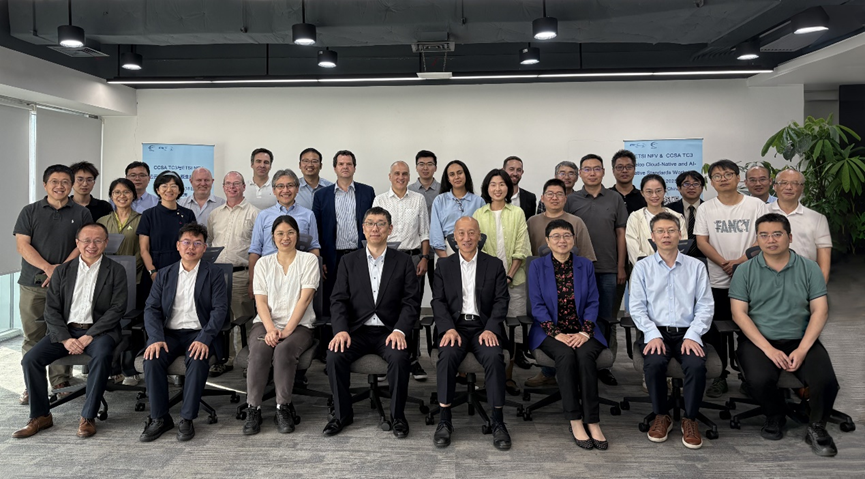The first joint Telco Cloud Roundtable, co-hosted by ETSI ISG NFV and CCSA TC3, was successfully held at China Telecom Information Park. This landmark event marked the first official collaboration between these two leading standard organizations and brought together over 40 industry experts from global operators and vendors, including NTT Docomo, China Mobile, China Telecom, China Unicom, BT, Huawei, NEC and Thales.

The roundtable reviewed the progress and industry adoption of NFV standards in both the virtualization and cloud-native phases of telecom networks. Discussions then turned to future visions and key technical directions for telco cloud in the AI-native era. The event was jointly organized by China Telecom and Huawei.
The meeting opened with remarks from Yoshihiro Nakajima, Chair of ETSI NFV, and Nan Xinsheng, Deputy Secretary-General of CCSA. Nan emphasized the strategic importance of NFV as the primary driver of the cloud transformation in the telecom industry and its significant role in the widespread deployment of China's 5G core networks. He pointed out that the advent of AI brings both opportunities and challenges for NFV development. CCSA will continue to foster an open and inclusive technology ecosystem, work with all parties in the industry to develop unified standards, and enhance standardization cooperation between China and Europe.
Zhao Huiling, Chair of CCSA TC3, and Kostas Katsalis, ETSI NFV representative, presented the latest updates from their respective standards groups and discussed the future architecture and evolution direction. CCSA is focusing on solving the challenges faced by NFV, such as further simplifying the network architecture, enhancing O&M capabilities, and reducing fault time. Looking forward, NFV needs to support 6G services, diverse telco cloud applications, and advanced automation and intelligence capabilities to facilitate the next-generation AI-empowered telco cloud foundation. ETSI NFV highlighted its focus on evolving the architecture and infrastructure to support emerging technologies like cloud-native design, AI/ML, and GenAI. The evolution of NFV is guided by principles of simplification, software portability across infrastructures, and native support for AI-driven operations through a reimagined NFV-MANO framework. This framework is also advancing towards telco cloud orchestration and management, encompassing key areas such as new reference architecture, independent operation, and energy efficiency.
During the operator sharing session, Huang Zhilan from China Telecom stated that telco cloud has entered a new 3.0 era characterized by AI-native capabilities. To meet future network agility demands, she suggested shifting from a resource-centric to a service-centric model, enhancing intelligence and ecosystem openness, and driving coordinated cloud-network operations. Zhang Hao from China Mobile noted that NFV infrastructure is evolving into a new paradigm of integrated compute-network-intelligence architecture, which requires a standardized and unified full-stack technology system to deliver intelligent computing and inference at the computing network resource layer, software layer, inference platform layer, and MaaS platform. Cao Chang from China Unicom emphasized that AI models and agents will accelerate telco cloud evolution across three dimensions: process automation, intelligent O&M, and autonomous networks — ultimately creating a self-aware cloud foundation for agile network applications. Key technologies such as intelligent hardware acceleration, containerized architecture, grayscale releases, and intelligent fault management will be continuously introduced.
During the vendor sharing session, Huawei emphasized the need to build intelligent telecom infrastructure in the AI era, integrating xPUs and AI enablement platforms. In light of challenges such as performance bottlenecks and increased heterogeneous deployments, Huawei recommended unifying telco cloud architecture to support both general-purpose and AI computing, along with establishing a unified MANO framework for resource and service management.
Panel discussion followed, focusing on open-source community evolution in telecom and the impact of AI and 6G on the future of telco cloud. Experts discussed key topics such as AI Pooling, distributed deployment, cloud-native and AI-native architectures. The sparking insightful debate offers multidimensional thoughts on the future direction of NFV.
With the rapid advancement of AI and 6G, telecom networks are encountering multiple challenges. This roundtable not only summarized the progress of NFV in the cloud-native era but also established a valuable platform for collaboration between ETSI and CCSA in the AI-native era. Moving forward, the two organizations will work closely to promote standard alignment and accelerate the industry-wide adoption of AI-native telco cloud technologies — enabling operators to embrace intelligent, efficient, and green networks.

